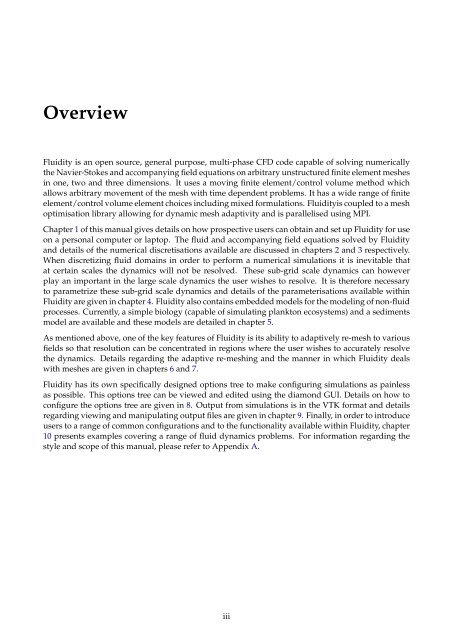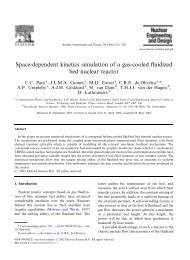Chapter 8 Configuring Fluidity - The Applied Modelling and ...
Chapter 8 Configuring Fluidity - The Applied Modelling and ...
Chapter 8 Configuring Fluidity - The Applied Modelling and ...
Create successful ePaper yourself
Turn your PDF publications into a flip-book with our unique Google optimized e-Paper software.
Overview<br />
<strong>Fluidity</strong> is an open source, general purpose, multi-phase CFD code capable of solving numerically<br />
the Navier-Stokes <strong>and</strong> accompanying field equations on arbitrary unstructured finite element meshes<br />
in one, two <strong>and</strong> three dimensions. It uses a moving finite element/control volume method which<br />
allows arbitrary movement of the mesh with time dependent problems. It has a wide range of finite<br />
element/control volume element choices including mixed formulations. <strong>Fluidity</strong>is coupled to a mesh<br />
optimisation library allowing for dynamic mesh adaptivity <strong>and</strong> is parallelised using MPI.<br />
<strong>Chapter</strong> 1 of this manual gives details on how prospective users can obtain <strong>and</strong> set up <strong>Fluidity</strong> for use<br />
on a personal computer or laptop. <strong>The</strong> fluid <strong>and</strong> accompanying field equations solved by <strong>Fluidity</strong><br />
<strong>and</strong> details of the numerical discretisations available are discussed in chapters 2 <strong>and</strong> 3 respectively.<br />
When discretizing fluid domains in order to perform a numerical simulations it is inevitable that<br />
at certain scales the dynamics will not be resolved. <strong>The</strong>se sub-grid scale dynamics can however<br />
play an important in the large scale dynamics the user wishes to resolve. It is therefore necessary<br />
to parametrize these sub-grid scale dynamics <strong>and</strong> details of the parameterisations available within<br />
<strong>Fluidity</strong> are given in chapter 4. <strong>Fluidity</strong> also contains embedded models for the modeling of non-fluid<br />
processes. Currently, a simple biology (capable of simulating plankton ecosystems) <strong>and</strong> a sediments<br />
model are available <strong>and</strong> these models are detailed in chapter 5.<br />
As mentioned above, one of the key features of <strong>Fluidity</strong> is its ability to adaptively re-mesh to various<br />
fields so that resolution can be concentrated in regions where the user wishes to accurately resolve<br />
the dynamics. Details regarding the adaptive re-meshing <strong>and</strong> the manner in which <strong>Fluidity</strong> deals<br />
with meshes are given in chapters 6 <strong>and</strong> 7.<br />
<strong>Fluidity</strong> has its own specifically designed options tree to make configuring simulations as painless<br />
as possible. This options tree can be viewed <strong>and</strong> edited using the diamond GUI. Details on how to<br />
configure the options tree are given in 8. Output from simulations is in the VTK format <strong>and</strong> details<br />
regarding viewing <strong>and</strong> manipulating output files are given in chapter 9. Finally, in order to introduce<br />
users to a range of common configurations <strong>and</strong> to the functionality available within <strong>Fluidity</strong>, chapter<br />
10 presents examples covering a range of fluid dynamics problems. For information regarding the<br />
style <strong>and</strong> scope of this manual, please refer to Appendix A.<br />
iii




